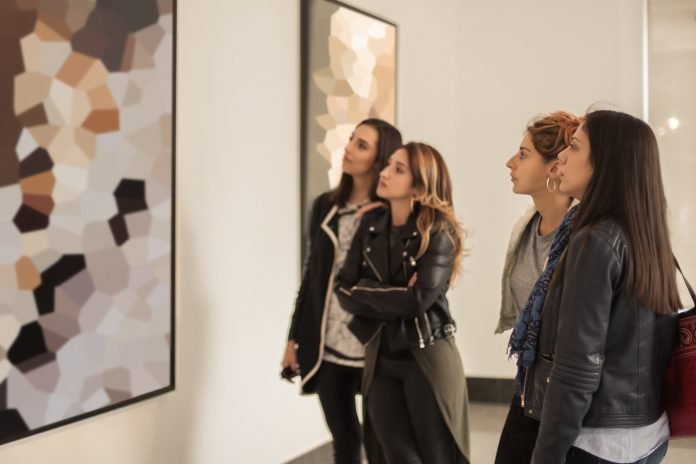Last Updated on February 14, 2024 by Nasir Hanif
Buying art is quite different than appreciating it.
There’s an art to buying art, and it’s an art that involves making a number of mistakes when you’re first starting out. You can avoid some of those artwork shopping mistakes by being mindful of a few things, though.
We’re going to try to look at things you should keep in mind when you’re starting an artwork collection for your home. Hopefully, the ideas below keep your collection feeling fresh and exciting instead of being vague and incredibly expensive.
Let’s get started!
Table of Contents
1. Thinking Cost Equals Quality
There is no bigger myth in the art world than the thought that notoriety and cost equate with quality. Sure, those pieces might be able to sell for more money, but that says nothing about how good the art actually is.
The value of art resides in your perception of it, not on the price tag. So, make sure that you’re not persuaded by big numbers that make the art feel inaccessible and deep when it’s really just someone’s afternoon scribblings.
By all means, though, if something expensive jumps up at you and grabs your heart, it’s worth buying. Comparing artwork costs might make your jaw drop when two very similar pieces differ by a margin of about $45,000, though, so keep your eyes open.
2. Forgetting Context
Another thing to consider is that artwork sits in the context of the room where you’ll place it. The position of the artwork makes all of the difference, and it might not be worth buying it if you need to force it into a particular space.
Think about your average 19 year old’s party house. Imagine the cardboard face of a 30-rack Bud Light box taped to the wall. In that context, the “artwork” doesn’t really make you think.
Transplant that box into the center of a massive white wall at the Smithsonian with the description “millions,” and you might really have something! It’s all about the way the artwork is presented.
Some art is more presentable than other art, but there’s a time and place for everything to hang on a wall. So, choose art to fit the spaces you want to fill.
3. Buying Art for Investment Growth
The practice of investing in fine art as an investment is a truly fickle one. At one point, finding a blossoming Picasso or Van Gogh and offering to be their patron would be an extremely wise choice.
If you were to support Picasso, paying for his housing and food to acquire one of his paintings per month, you would now be a multi-millionaire a few times over. Those instances are hard to find, though.
Further, buying particular works of art and waiting on their value to increase is risky, to say the least. It’s far wiser to put your money in the stock market if you’re trying to make money.
4. Forgetting The Frame
Keep in mind that framing your new piece of art might cost more than the artwork itself. It’s a silly thing that frames are exorbitantly priced, but that’s the way it is.
People who frame artwork do an excellent job and they actually add to the impression that the art gives. Subtle choices with color and frame texture can make all of the difference.
That said, you might be looking at a few hundred dollars to frame a medium-sized piece of art. So, factor frame cost into the buying process. You might consider looking for artwork that’s already framed or doesn’t need to get framed at all.
Another option is learning how to frame things yourself and saving a fortune over your lifetime.
5. Avoiding Commissions
Note that many artists accept commissions. Unless they’re doing extremely well in the art world, odds are that they have a price they’d be willing to commission some work for.
A lot of buyers steer clear of this, though, because it can be intimidating to consult with an artist about making something. In any case, you might be able to offer a fair price and get the most applicable, tasteful, and enjoyable work of art you’ve ever had in your home.
Just reach out. Most artists are available on Instagram and would be more than happy to see that someone wants a custom piece from them.
6. Skipping Over Photography
Photography is often an excellent addition to your wall. There are a lot of opportunities to work with photography, and it’s typically cheaper to scale images up than it would be to have an artist make a massive painting.
People steer right toward paintings and other visual art when they’re trying to build their collections. That said, photography is something that expresses just as much and can really influence the feeling of your room.
Take a look at garsha18photography.com to get some ideas as to what you might be able to do with a great piece of photography.
7. Overlooking Online Factors
Buying art online is difficult. There are too many different variables that might impact the way that your piece looks, gets delivered, and more. Artwork canvas size, material specifics, and impacts on the way that those manipulations change the image are all worth considering.
The last thing you want to do is to spend a significant amount of money and receive something that’s not what you were expecting it to be. Returns can be difficult and time-consuming as well.
A good way to get around these issues is to talk directly with the artist. If you’re going to handle things online, make sure that you have a clear conversation about the specifics of the piece, the way that the image changes if it’s being manipulated, the sizing, and anything else that seems relevant.
You can do this online, but it’s always more effective to talk on the phone.
Want to Avoid Artwork Shopping Mistakes?
Hopefully, our look at the artwork shopping mistakes was useful to you. There’s a lot more to learn starting an artwork collection, though. We’re here to help with more ideas.
Explore our site for insight into lifestyle tips, travel ideas, art inspiration, and a whole lot more.
Read More: Reasons why the cosmetic industry should invest in artwork management software



























